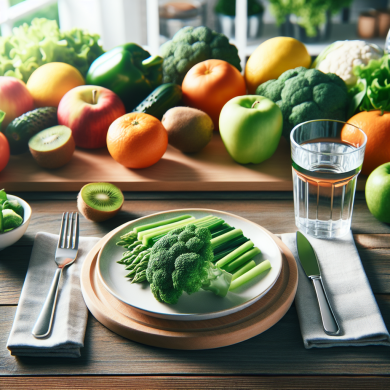Effortless Meal Prep for Clean Eating Success
Introduction
In today’s fast-paced world, maintaining a healthy diet can be a challenge. With hectic schedules and constant temptations at every corner, many find themselves reaching for convenience foods that are quick but often unhealthy. However, embracing clean eating doesn’t have to be complicated or time-consuming. By incorporating effortless meal prep strategies, you can set yourself up for success and enjoy nutritious meals every day without the stress.
Understanding Clean Eating
Clean eating is a lifestyle choice that focuses on consuming whole, minimally processed foods. It emphasizes the importance of ingredients that are as close to their natural state as possible. This approach not only nourishes the body but also promotes sustainable and mindful eating habits. Clean eating typically includes:
- Fresh fruits and vegetables
- Whole grains
- Lean proteins
- Healthy fats
- Minimal added sugars and processed foods
By prioritizing these foods, you provide your body with essential nutrients while reducing your intake of harmful additives and preservatives commonly found in processed foods.
The Benefits of Meal Prep
Meal prepping is the practice of preparing meals or meal components in advance, making it easier to stick to a clean eating regimen. The benefits of meal prep include:
- Time-saving: Dedicating a few hours a week to meal prep can save you significant time on busy weekdays.
- Cost-effective: Buying ingredients in bulk and preparing meals at home is often cheaper than dining out or purchasing pre-packaged meals.
- Portion control: Prepped meals allow for better control over portion sizes, helping manage caloric intake.
- Reduced stress: Knowing what you’re going to eat eliminates the daily stress of meal planning.
- Consistency: Regular meal prep ensures you have healthy meals readily available, reducing the temptation to resort to unhealthy options.
Steps to Effortless Meal Prep
1. Plan Your Meals
Start with a meal plan for the week. Decide on the number of meals you need and the types of foods you want to include. Consider creating a balanced menu that incorporates a variety of nutrients. Keep it simple to avoid feeling overwhelmed. Use resources like cookbooks, food blogs, or meal planning apps for inspiration.
2. Create a Shopping List
Once you have a meal plan, compile a shopping list of all necessary ingredients. Stick to your list to avoid impulse purchases that can derail your clean eating efforts. Buying in bulk can be economical, especially for staples like grains, seeds, and nuts.
3. Choose a Prep Day
Dedicate a specific day each week for meal prep. Many people find weekends ideal, but choose a day that works best for your schedule. Set aside a few uninterrupted hours to focus on preparing meals.
4. Batch Cook
Batch cooking involves preparing large quantities of a single ingredient or dish that can be used in multiple meals. For example, cook a big pot of quinoa, roast a tray of vegetables, or grill several chicken breasts. These can be mixed and matched throughout the week for variety.
5. Portion and Store
Divide your cooked ingredients into individual portions, using airtight containers for storage. Glass containers are a great option as they are durable, do not retain odors, and allow you to see the contents easily.
Organize your fridge and pantry to make it easy to grab what you need quickly. Label containers with the date to ensure freshness and reduce food waste.
6. Focus on Versatility
Choose ingredients that can be used in multiple ways. For example, grilled chicken can be added to salads, wraps, or served with a side of vegetables. This versatility keeps meals exciting and prevents monotony.
Tips for Successful Clean Eating Meal Prep
1. Keep It Simple
Don’t overcomplicate your meal prep. Stick to simple recipes that require minimal ingredients and cooking steps. This will make the process less daunting and more enjoyable.
2. Use Kitchen Tools to Your Advantage
Invest in kitchen tools that can speed up meal prep, such as a slow cooker, Instant Pot, or food processor. These tools can help prepare components like soups, stews, or chopped vegetables with minimal effort.
3. Embrace Freezer-Friendly Meals
Prepare meals that freeze well, such as soups, stews, and casseroles. This allows you to have a backup of healthy meals for weeks when time is particularly tight.
4. Experiment and Adapt
Don’t be afraid to try new recipes and adapt them to your taste preferences. Experimenting with spices and herbs can add variety to your meals without extra calories or sodium.
5. Stay Organized
Keep your kitchen organized and clutter-free. A tidy cooking space makes meal prep more efficient and enjoyable. Regularly declutter and restock your pantry with clean eating staples.
Conclusion
Effortless meal prep is the cornerstone of clean eating success. By planning ahead, organizing your ingredients, and dedicating time to meal preparation, you can enjoy nutritious, homemade meals with ease. These strategies empower you to take control of your diet, reduce stress, and maintain a balanced lifestyle. With practice, meal prep will become a seamless part of your weekly routine, leading to healthier eating habits and improved overall well-being. Embrace the art of meal prep, and savor the satisfaction of clean eating success.















Add comment